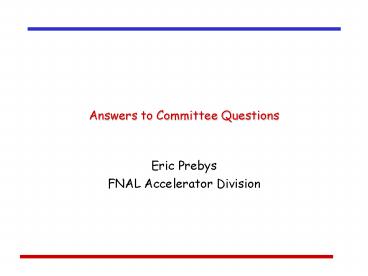Answers to Committee Questions - PowerPoint PPT Presentation
1 / 7
Title:
Answers to Committee Questions
Description:
Details of the collimator design can be found in Fermilab Beams document: ... 6.7E12 protons to transition, but can only get about ~5.5E12 through transition. ... – PowerPoint PPT presentation
Number of Views:14
Avg rating:3.0/5.0
Title: Answers to Committee Questions
1
Answers to Committee Questions
- Eric Prebys
- FNAL Accelerator Division
2
1. Any Information on Measured vs. Theoretical
Collimator Performance?
- Details of the collimator design can be found in
Fermilab Beams document - N.V. Mokhov, et al, Fermilab Booster Beam
Collimation and Shielding (BEAMS-DOC-622-v1). - Predicts average of .1 W/m _at_ 60 kW operation
- Prior to Collimators, saw 1W/m _at_ 20 kW operation
- -gt Expect factor of 30 reduction.
- Initial data indicate factor of 2-3 reduction so
far. - Things to consider
- Model does not adequately account for beam loss
at L13 region. - We do not yet effectively collimate horizontally,
due to beam motion.
3
2. Collimator Activation Limits and Maintenance
Strategy
- The collimators were designed so that all
potentially high maintenance components (i.e.
motors and LVDTs) are well away from the beam
and should remain quite cool (lt50 mR/hr _at_1 ft)
even at the highest intensity. - The hottest areas will be the beam pipe in the
region of the collimators. - This region is shielded from the aisle by an
iron curtain.
- Biggest worry would be replacing a BPM or
corrector package behind this wall, but we feel
that with proper planning, we could do this even
with activation gt 1R/hr _at_ 1ft. - This is a concern and we will continue to monitor
it.
4
3a - RF Voltage vs. Intensity
- We have gotten as many as 6.7E12 protons to
transition, but can only get about 5.5E12
through transition. - We believe that at least part of the problem
getting through transition is RF voltage. - Some details of measurements and calculation can
be found in FERMILAB-TM-2238 (J. Maclachlan, X.
Yang). - Primary effect seems to be real impedance, so to
first order, expect linear scaling with RFSUM - 1 or 2 cavities would be a 5 or 10 increase in
beam. - This is consistent with the effect of losing a
cavity. - Beam loss at a particular intensity more
difficult to model. - Efficiency seen to rise up to the highest RFSUM
we can achieve. - Increased reliability also a factor in decision
to add RF stations.
5
3b Gamma-t Jump
- We have implemented hardware improvements needed
to operate system at high rep. Rate. - Have demonstrated operation at moderate intensity
- Issues
- Alignment of pulsed quads beam kicked at
transition - Effect on coupled-bunch modes.
- Studies increased recently
- X. Yang, J. Maclachlan working together with
Argonne people (K. Harkay, J. Dooling, J. Norem). - Expect more definitive statements soon.
6
4. Heating/Rad damage in ORBUMP magnets
- Heating has been well modeled and should not be
an issue at all in the ferrite, even at the
highest rate. - The copper conductor will be water-cooled.
- All mechanical parts of the magnet (feed-thrus,
etc) are placed and designed to minimize
radiation damage. - There are no good data on the rad-hardness of
this particular ferrite - Based on experience with other ferrite, we
believe it is not an issue. - We will irradiate a sample to investigate the
potential for damage.
7
5. MI Losses with NuMI Running. A worry?
- Activation has not been an issue in the Main
Injector up until now. - Vast majority of the ring lt 20 mR/hr _at_ 1ft
- A few (2-3) points 50 mR/hr near small aperture
quadrupoles - Max 100 mR/hr near some Lambertsons
- Max NuMIslipstacking 10x current beam.
- Simple scaling would indicate activation would
become an issue, but not a major worry. - More studies needed on how losses scale with
multi-batches and slipstacking. - Obviously needs more attention in a Proton Driver
scenario.































